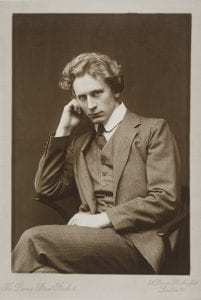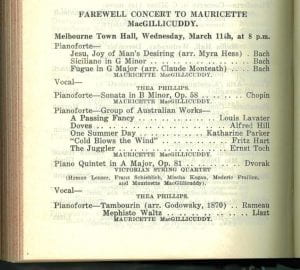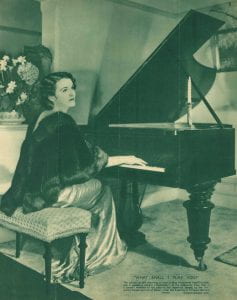Women of the Conservatorium: Mary Mauricette MacGillicuddy
In the Baillieu Library Rare Music Collection there is a series of seven untitled, clothbound scrapbooks, each containing newspaper clippings dating from 1930-1947. These scrapbooks reveal a snapshot of the Melbourne music scene and concert-life during that period. In particular, it provides an insight into the life of the Conservatorium of Music, its alumni and students. The fifth scrapbook contains the image reproduced here of Conservatorium student Mary Mauricette MacGillicuddy. Published in March of 1936, MacGillicuddy, then 23 years of age, was photographed in the lead up to her farewell concert at the Melbourne Town Hall. MacGillicuddy was about to venture abroad, where she would find fame, though perhaps not precisely in the form she, or her admirers, expected.
Before MacGillicuddy set off to explore the musical world in London, she had already lived an accomplished and eventful young life, full of prodigious musical talent, academic excellence, and social charm. Known as ‘Billie’ or ‘Bill’ to her friends and family, MacGillicuddy was born in Melbourne in 1913. She was the first child of Dr. Maurice MacGillicuddy and his wife, Nell Morris, well-known figures in Melbourne society at the time.[i] MacGillicuddy and her younger sister Joan, attended Catholic Ladies College in East Melbourne. From an early age, both MacGillicuddy sisters demonstrated a prodigious talent for music and performance. In 1927, at just 14 years of age, MacGillicuddy began her tertiary musical education at the University Conservatorium.[ii] In 1930, MacGillicuddy was awarded a three-years’ entrance exhibition, rendering her first three years free of tuition costs. She began studying piano and ‘music culture’ under eminent teacher of the pianoforte, Francis William Homewood, who described her as a musician of ‘rare insight and understanding’.[iii] In the following year, MacGillicuddy was awarded the Wright Prize and selected as the best instrumentalist of the year.[iv] MacGillicuddy continued to study and thrive at the Conservatorium until 1936. She consistently topped her year on the annual First-Class Honours list and received multiple awards including the Bursary League Prize (1932) and the Maud Harrington Prize for Accompanying (1933)[v].
 Beyond her academic success at the Conservatorium, while still a student, MacGillicuddy began to make a name for herself amongst the creative, musical milieu of Melbourne during the 1930s. In June of 1935, MacGillicuddy performed alongside the Melbourne Symphony Orchestra, playing to a capacity crowd led by renowned musician Percy Grainger, and conductor Sir Bernard Heinze at the Melbourne Town Hall.[vi] MacGillicuddy must have loved playing percussion alongside Mrs. Ella Grainger both of whom ‘danced before their instruments, snatching the implements from each other’.[vii]
Beyond her academic success at the Conservatorium, while still a student, MacGillicuddy began to make a name for herself amongst the creative, musical milieu of Melbourne during the 1930s. In June of 1935, MacGillicuddy performed alongside the Melbourne Symphony Orchestra, playing to a capacity crowd led by renowned musician Percy Grainger, and conductor Sir Bernard Heinze at the Melbourne Town Hall.[vi] MacGillicuddy must have loved playing percussion alongside Mrs. Ella Grainger both of whom ‘danced before their instruments, snatching the implements from each other’.[vii]


The brilliant MacGillicuddy quickly caught the attention of the Melbourne press, both as one of the most promising pianists emerging from the Conservatorium, but also as a bright and beautiful star of Melbourne society. Newspaper and magazine articles from the time reveal the press’s focus on MacGillicuddy’s photogenic beauty and charming manner, which was often considered just as, if not more important, than her obvious prodigious musical talent. Despite being regarded as one of the most promising talents emerging from the Conservatorium, her performances are often described in ways we would now consider superficial and patronizing: ‘Pianist Mauricette MacGillicuddy supplemented [the entertainment] with some prettily played Chopin’.[viii] Again, following an account of her remarkable academic success, Melbourne Chatter qualifies their praise by adding, ‘she is tall and slim, and music does not oust other interests from her young life’.[ix] This is a patent example of the prevailing patriarchal attitudes of the time that suggested MacGillicuddy’s professional accomplishments should not overshadow her value as an attractive, amiable young lady. One would like to think that these condescending statements would be gasped at these days. While no-doubt subtle for their time, readers of MacGillicuddy’s early career would have discerned that MacGillicuddy’s projected future as a celebrated concert pianist was not the principal concern of the press.
In 1936, MacGillicuddy completed her studies at the Conservatorium and, before departing for London with her family, performed at a farewell concert tendered by the Conservatorium in her honour. The Melbourne Town Hall was spruced up especially for the occasion.[x] Displaying a masterly grasp of technique and smoothness of style, MacGillicuddy performed to a full house and presumably many others, as the performance was broadcast for ABC Radio.[xi] In April, accompanied by her parents and her younger sister Joan, MacGillicuddy departed Melbourne for London to further her musical education. The young ‘poet of the piano’ had visions of studying piano under Schnabel and soaking in the creative milieu of London, hearing the best musicians of the age.[xii]
 By the end of 1937, MacGillicuddy, or ‘Mauricette Melbourne’ as she was then known, was making a name for herself in the UK not as a concert pianist as expected, but rather as a professional whistler. MacGillicuddy’s superior command of this unusual musical art quickly set her apart and by February of 1938 she had already featured on several radio and television broadcastings. Rumours began circulating of an international career in whistling.[xiii] This unique gift, which was described by Noel Coward as ‘the most exquisite thing [he] ever heard’, earned MacGillicuddy the praise of an independent Hollywood producer.[xiv] In 1941, MacGillicuddy relocated to the United States to play the role of Rima, the bird girl, in W.H. Hudson’s ‘Green Mansions’.[xv]
By the end of 1937, MacGillicuddy, or ‘Mauricette Melbourne’ as she was then known, was making a name for herself in the UK not as a concert pianist as expected, but rather as a professional whistler. MacGillicuddy’s superior command of this unusual musical art quickly set her apart and by February of 1938 she had already featured on several radio and television broadcastings. Rumours began circulating of an international career in whistling.[xiii] This unique gift, which was described by Noel Coward as ‘the most exquisite thing [he] ever heard’, earned MacGillicuddy the praise of an independent Hollywood producer.[xiv] In 1941, MacGillicuddy relocated to the United States to play the role of Rima, the bird girl, in W.H. Hudson’s ‘Green Mansions’.[xv]
Both MacGillicuddy and her sister Joan Winfield would remain in the US for many years, as they both embarked on celebrated acting careers. They performed in several films and stage productions throughout the 1940s. Under her new stage name, Dale Melbourne, MacGillicuddy appeared in plays across the US, perhaps most notably as Nora in James B Cassidy’s production of Ibsen’s A Doll’s House, which toured North America in 1944-1946.[xvi]

John E. Reed Studio, Hollywood, portrait of Mauricette MacGillicuddy http://icelegendsaustralia.com/1stIceChampions-hockey-intro.html
Mauricette MacGillicuddy, (aka Bill, aka Mauricette Melbourne, aka Dale Melbourne) died in 1998 following a battle with Alzheimer’s disease, which was diagnosed in 1997.[xvii] Her life and career as an artist and performer spanned three continents. She was survived by her adoring husband John Herklotz, whose philanthropic donations, most notably the Dale Melbourne Herklotz Conference Room at the Centre for the Neurobiology of Learning and Memory at the University of California Irvine, and the ‘Dale Melbourne Herklotz Memorial Endowed Scholarship’ of the School of Music, DePaul University, Chicago, sustain the memory of the extraordinary Mauricette MacGillicuddy.[xviii]
By Caroline Colbran
Rare Music intern
[i] The Bulletin – ‘Melbourne Chatter’, v.51, no.2614, 1930-03-19, p.48
[ii] The Advocate – ‘Women’s World’, 1930-03-06, p.32.
[iii] The Advocate – ‘Women’s World’, 1930-03-06, p.32; The Bulletin – ‘Melbourne Chatter’, v.51, no.2614, 1930-03-19, p.48
[iv] The Herald – ‘The Woman’s World: Pianist Wins Prize’, 1931-02-01, p.8.
[v] University of Melbourne 1933-1936 Music Prospectuses; The Bulletin – ‘Melbourne Chatter’ v.55, no.2825, 1934-04-04, p.37.
[vi] University of Melbourne 1936 Music Prospectus; The Bulletin – ‘Shadoh Shohs: Some First Nights’, v.56, no.2889, 1935-06-26, p.40;
[vii] The Bulletin – ‘Shadoh Shohs: Some First Nights’, v.56, no.2889, 1935-06-26, p.40
[viii] The Bulletin – ‘Melbourne Chatter’, v.54, no.2790, 1933-08-02, p.37; The Bulletin – ‘Melbourne Chatter’, v.51, no.2614, 1930-03-19, p.48.
[ix] The Bulletin – ‘Melbourne Chatter’ v.55, no.2825, 1934-04-04, p.37.
[x] The Bulletin – ‘Melbourne Chatter’ v.57, no.2927, 1936-03-18, p.43.
[xi] The Bulletin – ‘Melbourne Chatter’ v.57, no.2927, 1936-03-18, p.43; The Wireless Weekly – ‘The Hundred per cent Australian Radio Journal’, v.27, no.10, 1936-03-06, Wednesday.
[xii] The Australian Women’s Weekly – ‘What Women Are Doing’, 1936-02-15, p.25.
[xiii] The Bulletin – ‘Melbourne Chatter’, v.59, no.3027, 1938-02-16, p.36; The Argus – ‘Australians Striving for Musical Fame’, 1939-05-20.
[xiv] The Sun – ‘Girl Whistles Her Way to Stardom’, 1941-02-19, p.3; The Herald – ‘Miss M. MacGillicuddy “Green Mansions”, 1941-02-19, p.11.
[xv] The Sun – ‘Girl Whistles Her Way to Stardom’, 1941-02-19, p.3; The Herald – ‘Miss M. MacGillicuddy “Green Mansions”, 1941-02-19, p.1.
[xvi] The Herald – ‘Pin-Up Girl from Melbourne’, 1945-04-18, p.6.
[xvii] Carpenter, R (2007), ‘Dr Cyril Florance MacGillicuddy, MM.BS’, Legends of Australian Ice, http://icelegendsaustralia.com/1stIceChampions-hockey-intro.html
[xviii] Ibid
Categories

Leave a Reply